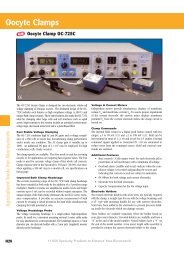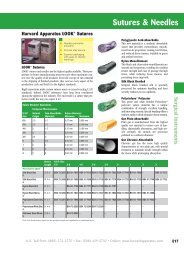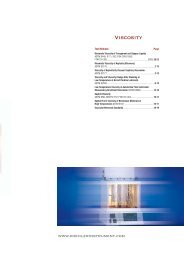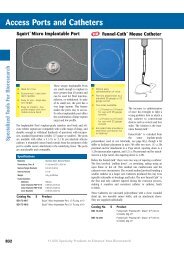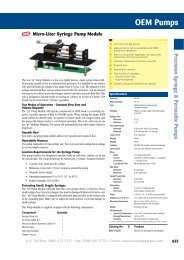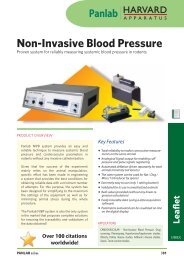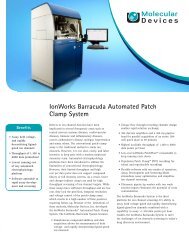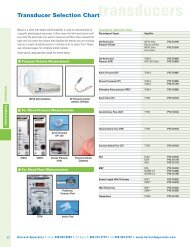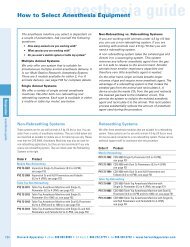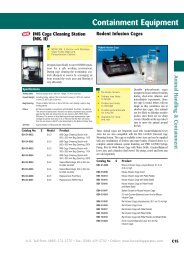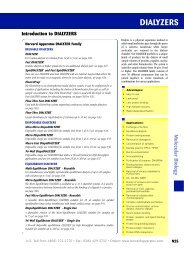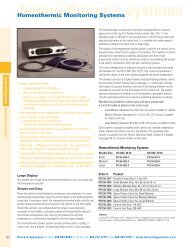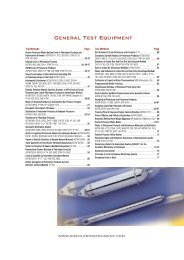anesthesia guide
anesthesia guide
anesthesia guide
You also want an ePaper? Increase the reach of your titles
YUMPU automatically turns print PDFs into web optimized ePapers that Google loves.
<strong>anesthesia</strong> equipment<br />
Anesthesia and Evacuation Systems<br />
PY2 72-3025<br />
(Vaporizer<br />
not included)<br />
Multi-Station<br />
Research Anesthesia<br />
System<br />
• Anesthesia delivery<br />
system designed<br />
specifically for research<br />
• Multiple, individually<br />
controlled stations in<br />
a single unit<br />
• Unique rodent circuit,<br />
mask and diaphragm<br />
system for safe,<br />
effective anesthetic<br />
agent delivery<br />
• Use with lab animal<br />
evacuation system<br />
The Multi-Station Research Anesthesia System is the latest technology for<br />
rodent and small animal <strong>anesthesia</strong>. The multi-station unit offers a base unit<br />
with multiple stations each individually controlled. The master flowmeter and<br />
auxiliary flowmeters all receive the same gas supply. The master flowmeter<br />
combined with an anesthetic vaporizer, Series T3, see page F36, are used to<br />
set the maximum percentage of anesthetic agent delivered to each station.<br />
Using the auxiliary flowmeters, the percentage of anesthetic agent can be<br />
diluted using the fresh gas supply from the auxiliary flowmeter. Using an<br />
easy-to-follow flow chart, each individual station can deliver a different<br />
percentage of anesthetic agent as needed, without effecting any other station.<br />
The unique rodent circuit, PY2 72-3026 features a coaxial tube used in<br />
conjunction with a mask. By placing the animal’s nose into the mask<br />
diaphragm, it receives the delivered gas/anesthetic agent mixture. Three<br />
different size diaphragms are available. The waste gas exhaled from the<br />
animal and any unused gas delivered by the <strong>anesthesia</strong> machine, is pulled<br />
around the inner cone through the outside hose of the Rodent Circuit. This<br />
waste gas can be removed from the breathing circuit using either in-house<br />
vacuum or the Lab Animal Evacuation system, PY2 72-3066. The unit is a<br />
simple to use, safe and effective anesthetic delivery and evacuation system<br />
designed specifically for laboratory research use.<br />
The Multi-station Research Anesthesia system is available with two (2), four<br />
(4), or six (6) stations. It is supplied with an operational manual, station hoses,<br />
rodent circuits which include, a mask, hose and a medium diaphragm and<br />
endcaps. A vaporizer, see page F36, and evacuation system must be<br />
purchased separately.<br />
An alternative to the Lab Animal Evacuation system is to connect each rodent<br />
circuit exhaust/exhalation line to it’s own F-Air Filter canister, see page F34.<br />
Order # Product<br />
PY2 72-3023 Lab Animal 2 Station Multi-Station Research System,<br />
2 animal<br />
PY2 72-3024 Lab Animal 4 Station Multi-Station Research System,<br />
4 animal<br />
PY2 72-3025 Lab Animal 6 Station Multi-Station Research System,<br />
6 animal<br />
PY2 72-3026 Circuit Set, Rodent, see page F41<br />
PY2 72-3027 Mask, Rodent (no diaphragm)<br />
PY2 72-3028 Rodent Mask Diaphragm Small (7/16 in Diameter)<br />
PY2 72-3029 Rodent Mask Diaphragm Medium (9/16 in Diameter)<br />
PY2 72-3030 Rodent Mask Diaphragm Large (3/4 in Diameter)<br />
<strong>anesthesia</strong> equipment Respiration<br />
PY2 72-3066 Lab Animal<br />
Evacuation System<br />
Lab Animal Evacuation System<br />
The Multi-Station Evacuation System was designed for those facilities that<br />
do not have a built-in evacuation system or a fume hood is not available. The<br />
waste gas from the system may be vented to a 2 inch outside line or pulled<br />
through activated charcoal so that the air can be recirculated in to the room.<br />
When using the filtration system, the activated charcoal must be changed on<br />
a regular basis, to maintain it’s effectiveness. Typically, 8 to 10 hours of<br />
<strong>anesthesia</strong> delivery can be performed for each new supply of charcoal. The lab<br />
evacuation system, will accommodate waste gas supply from 1 to 6 stations.<br />
PY2 72-3026<br />
Rodent Circuit Set<br />
Order # Product<br />
PY2 72-3066 Lab Animal Evacuation System, 110 VAC, 60 Hz<br />
PY2 72-3046 Lab Animal Evacuation System, 220 VAC, 50 Hz<br />
PY2 72-3067 Charcoal Refill<br />
NOTE: When using in-house suction, a scavenger interface valve must be used when operating<br />
more than one station, to reduce the pull of air.<br />
✐<br />
NOTE:<br />
To adapt port to 3/16" tubing,<br />
PY2 72-6000 and PY2 72-8209 are<br />
required–one of each per port to be adapted.<br />
Harvard Apparatus • phone 508.893.8999 • toll free U.S. 800.272.2775 • fax 508.429.5732 • www.harvardapparatus.com<br />
F33



